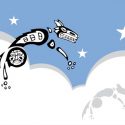A New Framework

Harry with Margaret Holding who taught him to read and write in English Photo taken in Omak Washington 1922
Lesson 2.3 Assignment 2.6
4] In the last lesson I ask some of you, “what is your first response to Robinson’s story about the white and black twins in context with our course theme of investigating intersections where story and literature meet.” I asked, what do you make of this “stolen piece of paper”? Now that we have contextualized that story with some historical narratives and explored ideas about questions of authenticity and the necessity to “get the story right” – how have your insights into that story changed?
The first consideration that needs to be made, before answering this question, is determining where Harry Robinson’s story about the white and black twins, from Living by Stories: a Journey of Landscape and Memory fits into the literary canon. When I first read the stories, I felt they neatly fell into the genre of postcolonial literature. My first reaction was that the story was influenced by colonization. This seemed to be the case, because one of the twins is white, and is sent across the water to become the forefathers of the English inhabitants. Additionally, I felt that the story itself was a parallel to the events that occurred as a result of colonization. When I first read the story, I focused more on how the Europeans used written language and laws to justify their actions both during and after colonization. However, after reading Thomas King’s analysis of First Nation’s literature from his article, “Godzilla vs. Post-Colonial”, I reconsidered my original position (King).
King refuses to accept the term postcolonial as a description for Native literature, and instead provides several alternatives. Two options that more accurately describe Robinson’s genre, are polemical and interfusional literature. Polemical is “literature either in a Native language or in English … that concerns itself with the clash of Native and non-Native cultures or with the championing of Native values over non-Native values” (King 186). Interfusional is “Native literature that is a blending of oral literature and written literature” (King 186).
Before considering whether Robinson’s work is either polemical or interfusional literature, I want to examine the term, postcolonial literature. According to King, after he breaks down the assumptions that go into postcolonial literature, he concludes it is “literature produced by Native people sometime after colonization, a literature that arises in large part out of the experience that is colonization (King 184). Brians, in his article “Postcolonial Literature”: Problems with the Term, concurs, “[t]aken literally, the term “postcolonial literature’ would seem to label literature written by people living in countries formerly colonized by other nations” (Brians). However, Brians adds to this, and once again concurs with King, when he writes, “there are many problems with this definition” (Brians). From here, Brians raises several good points. One is that literature written by peoples who have not received independence from the colonizers, should be considered “’postcolonization’ literature”. Another important point he raises is that even using the term postcolonial, when referring to literature, is “Eurocentric”, because “it singles out the colonial experience as the most important fact about the countries involved” (Brians). Click here to read the entire article (Brians).
King’s description of polemical is a sound depiction of Robinson’s story, and provides the proper condition to absorb Robinson’s words. Now when I read Robinson’s stories, I look at it from a different point of view. Instead of only seeing the stolen paper as a parallel to the acts committed by the Newcomers, I can also consider the story from the point of view of the First Nations peoples. Taking into consideration Brians comment about Eurocentric, I can move my view to the centre and see the story on an level playing field. Instead of privileging “one culture over another” (King 185), I can look at the story from the point of view that “Chapter 1 of the story”, is the same chapter of the same story for both First Nations people of Canada as well as Europeans (Asch 36). I can understand that Robinson’s story is a retelling of this first chapter, and it affects both parties. Conversely, I can see that the time of colonization was “chapter 15” for both Newcomer as well as Native (Asch 37). What this means is that both the Europeans and the Natives stories began long before colonization, and the act of colonization was for both a part of their separate and joint histories.
Schorcht writes in her article, “The Storied World of Harry: Emerging Dialogues”, that “Robinson incorporates European elements and content into his stories in ways that reflect the spirit and worldview of an Okanagan storyteller” (Schorcht 147). Her discourse supports the position that Robinson’s writing is in fact closer to King’s term of polemical than it is to the term postcolonial. Schorcht writes, “Robinson makes a clear distinction between his own stories, which have an underlying Okanagan context and history, and stories that have European sources” (156). (Click here for the full article (Schorcht).)
King’s description of interfusional literature also works with Robinson’s story. This story, as well as others that Robinson tells, bridges oral storytelling with written literature. Robinson’s story is a fusion, because although the story is written in English, it remains in the oral tradition through it’s “patterns, metaphors, structures as well as the themes and characters” (King 186). Robinson’s voice can be heard in the written words, and King suggests the stories work best when read aloud.
Regardless of whether or not Robinson’s story falls under the genre of polemical or interfusional, it is clear to me that postcolonial will not do. A new framework is required that will provide a platform for mutual understanding. When reading Robinson’s stories about the twins, the meaning is clearer, and easier to understand when the reader (or listener) hears the words from a point of view that takes both twin’s position into consideration.
Works Cited
Asch, Michael. “Canadian Sovereignty and Universal History.” Storied Communities: Narratives of Contact and Arrival in Constituting Political Community. Ed. Rebecca Johnson, and Jeremy Webber Hester Lessard. Vancouver: U of British Columbia P, 2011. 29 – 39. Print.
Brians, Paul. “Postcolonial Literature”: Problems with the Term. Washington State University. n.p. 7 Aug 1998 Web. 26 June 2016.
“Harry Robinson with Margaret Holding, who taught him to read and write in English”. 9 March 2016. Digital Image of Photo taken in Omak, Washington, 1922. BC Book Look. Web. 26 June 2016.
King, Thomas. “Godzilla vs. Post-Colonial.” Unhomely States: Theorizing English-Canadian Postcolonialism. Peterbough, ON: Broadview, 2004. 183- 190. Handout.
Robinson, Harry. Living by Stories: a Journey of Landscape and Memory. Ed. Wendy Wickwire. Vancouver: Talonbooks, 2005. Print.
Schorcht, Blanca. “The Storied World of Harry: Emerging Dialogues”. BC Studies, no 135, (Autumn 2002). 145-162. Web 29 June 2016. http://ojs.library.ubc.ca/index.php/bcstudies/article/viewFile/1640/1685
“Wendy Wickwire and Harry Robinson”. 9 March 2016. Digital Image of Photo taken in Omak, Washington, 1922. BC Book Look. Web. 26 June 2016.










